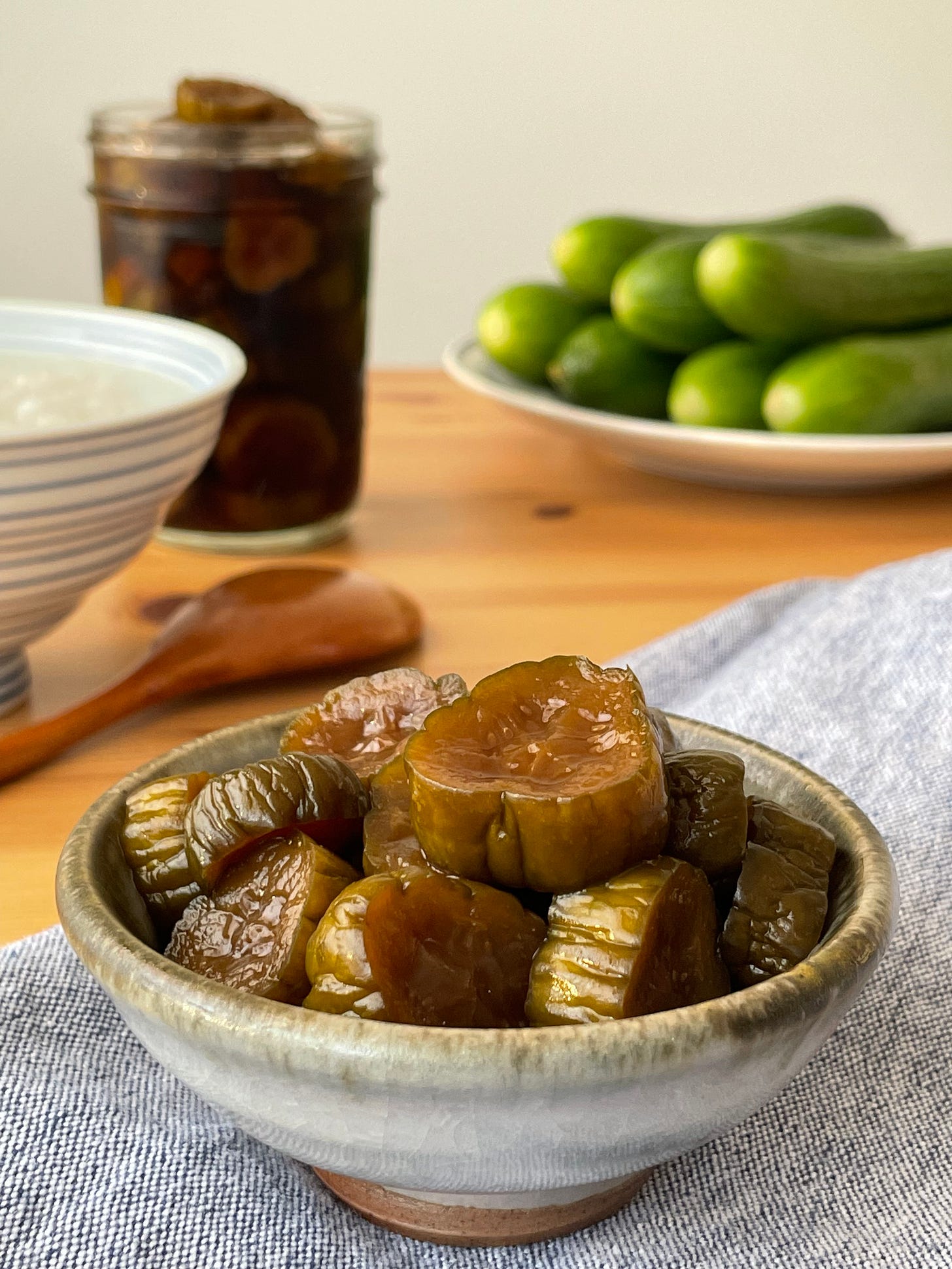Tsuigua: Soy Marinated Cucumbers (脆瓜)
The pickle most commonly consumed with congee is not hard to find but just as easy (and so much better) to make at home
Tsuigua is one of those things I expect to always be there whenever congee is served. Unlike Western dill pickles which pack quite a sour bite, these Taiwanese pickles are pretty balanced in saltiness, sweetness, and acidity. And quite frankly, I wouldn’t feel right not having a jar or two in my pantry. I might even be confident enough to say most Taiwanese households have these in the house somewhere. Together with pork fiber (or the equally unfortunate translation: pork floss) and seitan, they make up my congee accouterments trifecta.
So believe me when I say I felt so accomplished after making a batch of tsuigua myself. I even got a round of thumbs up from my Taiwanese friends when I had them over for Taiwanese New Year. “They taste like the canned ones!“ my friend Marc uttered. They are, if I may say, even better than the canned stuff!
The canned versions (which often go by a myriad of names such as tsuigua, huagua, heigua) share the sad fate of perpetually not being crunchy enough, and perhaps a little too salty, a little too tired. A familiar presence, canned tsuigua you are, but all in all it can be in the “nothing’s wrong with it but nothing's exciting either“ territory. Also, some people are not fans of the long lists of flavor enhancers and artificial preservatives.
The from-scratch tsuigua is not only crunchier, but the use of rice vinegar and licorice gives it such a nice tang and a sweet, refreshing aftertaste. The technique of quickly blanching the cucumber in boiling pickling liquid might have you worried there for a second, but it’s what gives the tsuigua its signature texture and flavor. The pickles will come out crunchy and not mushy at all.
This recipe uses a pack of Persian cucumbers, my preferred kind for these pickles. I bought my licorice root crushed in a 1-lb bag from Frontier Co-op. You can also try Chinese herbal shops in your closest Chinatown, or purchase them in dried slices online.
This recipe makes two 16 oz jars of pickles. It’s easy to scale up the recipe as they make wonderful gifts for friends and family during the holiday season.
INGREDIENTS
1 lb of Persian cucumbers
1/2 cup water
1/2 cup regular soy sauce
1/3 cup rice vinegar
1/3 cup granulated sugar
1 tbsp crushed licorice root (optional)
DIRECTIONS:
Wash and cut cucumbers: Wash cucumbers well and slice into coins, about 1cm or about 1/2” thick.
Heat up pickling liquid: In a pot, heat up the soy sauce, water, sugar, vinegar, and licorice until boiling, stirring well until the sugar’s dissolved.
Blanch the cucumber in pickling liquid: In batches, add in cucumber, and cook until the pickling liquid reboils, about 1-2 minutes. Transfer cucumber to clean glass jars with a slotted spoon. Repeat until all the cucumber has been parboiled. It’s totally normal to see wrinkles on the cucumbers, and the green of the skin fade in color. They will still be crunchy, I promise!
Add the pickling liquid to the jar(s) to cool: It should cover most of the cucumber, don’t worry if a few slices are exposed on top, as the cucumber will release more water as it sits and sinks to the bottom.
Put the jars in the fridge and chill for at least 24 hours before serving. Keep refrigerated and it can keep for 2 weeks in the fridge.
Serving Suggestions
Besides serving with congee or plain rice, tsuigua is often incorporated into ground pork as guatserou (瓜子肉), either steamed as a meat patty or sauteed and poured over rice. It also works as a flavoring agent in chicken soup. Simply add some tsuigua when making chicken soup along with a few tablespoons of the pickling liquid and you’ll have a nice clear broth chicken soup that has the base of ginger and shitake mushrooms but is also packed with additional umami.
In the next post, we’ll check on the progress of my homemade salted duck eggs. With tsuigua and salted duck egg yolks, we’ll then look at how to make guatserou, so stay tuned!








